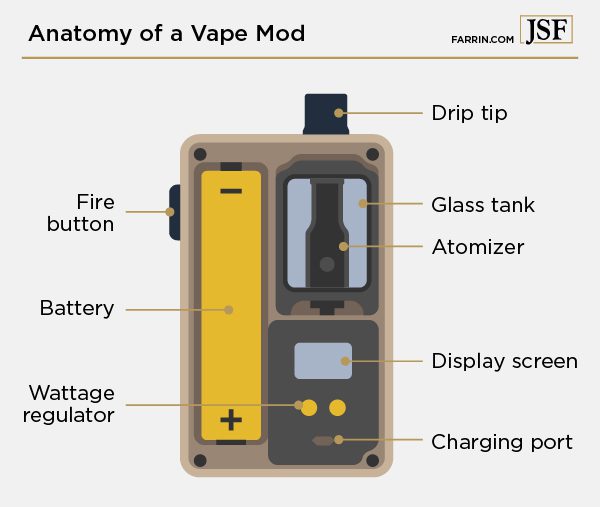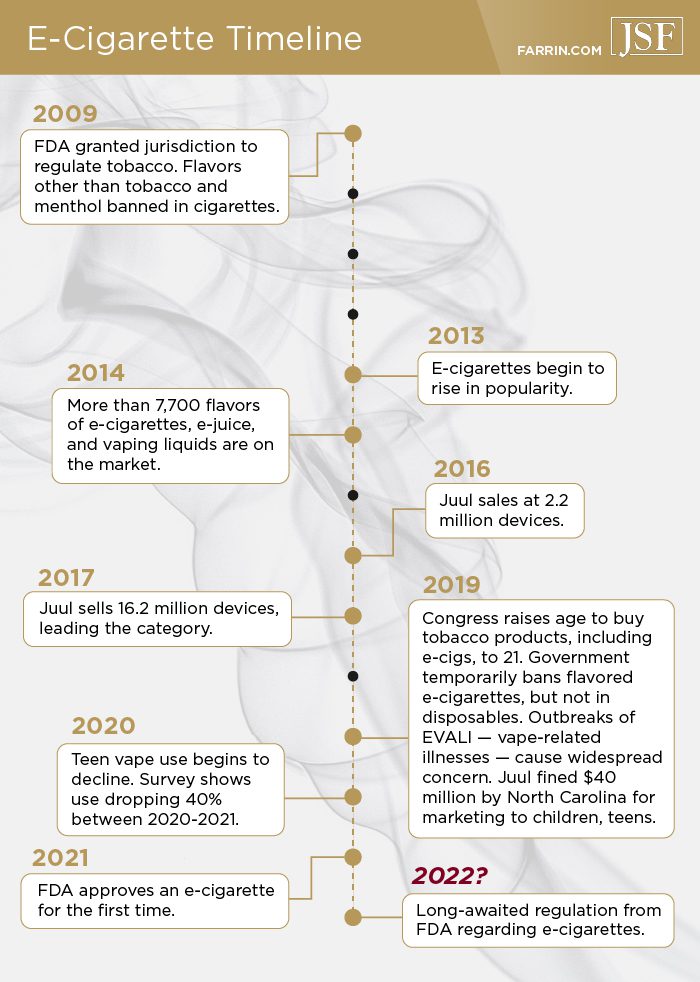In 2019, teen vape usage was rising quickly. Vaping companies, specifically Juul, were under fire for marketing to kids and teens. And Juul was under additional pressure after reports that it had not recalled contaminated vaping pods. Vaping lawsuits were filed. “Vaping injury attorney” entered the lexicon.
Here’s where I remind you that I’m not just a lawyer – I’m a parent as well. I’m in the same boat with every other parent. Vaping was (and still is) a crisis, and people were doing whatever they could to understand the teen vaping epidemic and put a stop to it.
But what’s happened since 2019?
The Vaping Crisis, a Brief History
Originally billed as a “safer alternative to smoking,” vaping brought with it an entirely new set of dangers. Nicotine is still highly addictive and can harm the development of the brain in younger people. The difference in delivery – vapor versus smoke – was thought to be better and possibly reduce the risk of lung cancer. That was an implication, if not an outright claim.
Vaping devices (called mods) store the vaping liquid (called juice or e-juice) in a tank and allow users to adjust the vapor, juice, and nicotine to their preferences. They work by heating the liquid and creating the vapor for users to inhale.
Perhaps the most crucial factor is the ability to flavor the liquids. E-juice comes in many flavors, including a variety of fruit flavors and mint, among others. Rather than taste tobacco or smoke, users can choose how their nicotine liquid tastes.
And that’s where it catches on with kids.
Flavored Cigarettes Were Banned Years Ago
According to CounterTobacco.org, the sale of cigarettes with flavors other than tobacco and menthol was banned by the 2009 Family Smoking and Tobacco Prevention Act. Data correlates the ban with a 17% reduction in the likelihood that middle schoolers and high schoolers start smoking and a 58% reduction in cigarette use by kids who smoked.
Most kids didn’t just abandon smoking – it’s an addiction after all. The data suggested that, in the absence of flavored cigarettes, kids smoked cigars (34% usage increase) and flavored tobaccos in pipes (55% usage increase). Meanwhile, the overall probability of kids using tobacco of any kind dropped by 6%.
In other words, kids are drawn to flavored products. In vaping products, it was perfectly legal for a while.
Marketing to Kids: Juul Travels a Familiar Tobacco Road
The rise of vaping somewhat coincided with the rise of vaping company Juul, which led in market share. The company was hit with lawsuits claiming it marketed to kids and teens, which was relatively easy to prove. It bought ad space on Nickelodeon and Cartoon Network
The company’s then-CEO Kevin Burns was quoted as saying, “I hope there was nothing that we did that made it appealing to them.” It was in response to parents of vape-addicted teens.
Couple this with a survey suggesting that 63% of Juul users aged 15-24 were unaware that all Juul products contained nicotine, and you see how deep the problem goes. Then consider that one of Juul’s primary investors and owner of one-third of the company is Altria, the parent company of Philip Morris USA – big tobacco, in other words.
Leading the Market, With Sales to Kids Leading the Way
The rabbit hole here is deep, and it contains nothing but bad news. The Centers for Disease Control performed an analysis of e-cigarette retail sales for 2013-2017. By December 2017, Juul represented nearly one in every three e-cigarette sales. That did NOT include internet sales and sales in vape shops.
Between 2016 and 2017, Juul sales increased 641%, from 2.2 million devices sold to 16.2 million devices sold.
And according to small-sample survey data from the Truth Initiative in 2018, 74% of 12- to 17-year-old Juul users said they’d obtained it at a retail store. Remember that all Juul products contain nicotine. How kids can purchase a nicotine product is another question entirely. By September 2018, Juul accounted for 73% of e-cigarette sales in the US, thanks in no small part to its popularity among youth.
Meanwhile, the FDA has continually delayed its regulation of e-cigarettes. It has missed its deadline by five years and announced it would begin fully regulating these products in 2022. In 2020, about 20% of high school students used some form of e-cigarette, many of whom have never smoked a traditional cigarette.
The Teen Vaping Epidemic and Government Response
Despite the FDA’s delays, the government was not wholly idle. While the government granted the FDA jurisdiction to regulate tobacco products in 2009, relentless lobbying efforts seek to roll back that oversight.
In 2019, Congress increased the minimum legal sales age (MLSA) for tobacco products to 21 as part of US HR1865 and included e-cigarettes. In 2021, Congress enacted the so-called “Vape Mail Ban” as part of the spending bill (US HR 133). Despite the nickname, the act did not “ban” the mailing or shipping of vaping products but instead required retailers to verify customers’ ages and collect and report data, among other restrictions.
Some states and municipalities have passed bans of their own. In September 2019, the government issued a temporary ban on flavored e-cigarettes, but the ban contained loopholes. Specifically, the ban did not include disposable e-cigarettes. Users simply switched away from reusable vapes to disposable products.
Flavors Banned in Cigarettes for Appealing to Youth
Flavoring has long been under scrutiny and was mostly banned in tobacco in 2009. The law defines “flavors” as:
“an artificial or natural flavor (other than tobacco or menthol) or an herb or spice, including strawberry, grape, orange, clove, cinnamon, pineapple, vanilla, coconut, licorice, cocoa, chocolate, cherry, or coffee, that is a characterizing flavor of the tobacco product or tobacco smoke.”
The government implemented the ban because flavored products appeal more to youth. That’s remained true. If you need evidence, look no further than the boom in flavored e-cigarettes, e-juice, and vaping liquids. In 2014, there were 7,765 flavors across more than 400 brands.
The move to treat e-cigarettes and vaping like traditional smoking, then, was overdue.
New Health Dangers Join Old Health Dangers
Despite initially being billed as “healthier” or less risky than smoking, vaping has proved to have its own group of health risks. In 2019, the CDC advised people to discontinue vape use due to an outbreak of severe lung injuries we now call EVALI (e-cigarette, or vaping, product use associated lung injury).
According to an article in Yale Medicine, thousands of cases and dozens of deaths were reported, and symptoms varied widely, including cough, chest pain, and shortness of breath to fatigue, vomiting, diarrhea, weight loss, and fever. About 15% of EVALI patients were under the age of 18.
Meanwhile, an American Journal of Preventive Medicine study found that people who used vapes and e-cigarettes increased their risk of lung disease by around 30% versus people who did not use the products.
And nicotine, the addictive chemical at the heart of it all, is still linked to a variety of health issues including:
-
- Cancer
-
- Cardiovascular diseases
-
- Respiratory diseases
-
- Gastrointestinal disorders
-
- Immune response problems
The human brain doesn’t finish developing until about age 25, and nicotine can interfere with that process, causing permanent damage. Nicotine disrupts the part of the brain that controls attention, learning, mood, and impulse control, and people are more susceptible to addiction before the brain is fully developed.
The Effects of Flavor Bans, Fines, the Pandemic, and the Path Forward
In 2019, North Carolina fined Juul $40 million for its marketing to young users. The flavor bans that went into effect took a massive bite out of its market dominance as well. Among high school users, Juul was 4th with just 5.7% of users.
The new leader was Puff Bar, not coincidentally a maker of disposable e-cigarettes not subject to the flavor ban. It’s worth noting that among current youth e-cigarette users, 84.7% used flavored products (85.8% of high school users, 79.2% of middle school users).
Still, according to survey data, teen vaping use dropped by 40% between 2020 and 2021. Part of this may be attributed to the flavor bans, but social factors are also in play. During the COVID-19 pandemic, kids were not in their usual social structure and around other kids. Less peer pressure may be one cause for the drop. Additionally, as of this writing, the last survey was answered when kids were at home, and proximity to their parents may have affected their answers. Only time will tell.
The FDA’s much-delayed regulation declaration is due in 2022, though the politics and lobbying around it are likely to be intense. Big tobacco continues to lobby, and it still spends a great deal of money in the political sphere. Meanwhile, with laws regulating online purchases and minimum age requirements raised, it should be more difficult for kids to get vaping products and e-cigarettes.
In October 2021, the FDA approved an e-cigarette for sale for the first time. Ostensibly, this is a sign of the agency’s assertion of regulatory power. In effect, it was an approval of the product. We’ll see what the future brings and what the FDA decides to do. As a parent living in North Carolina, it feels like a lot of déjà vu.
You May Also Be Interested In
Do Teens Make North Carolina’s Roads More Dangerous?
Teen Drivers and How to Keep Them Safe on the Road
Driving High: What Marijuana Car Accident Statistics Teach Us





